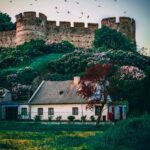The Manaslu Circuit Trek is a remarkable journey that takes you through one of Nepal’s least explored and most stunning trekking regions. This trek, circling the majestic Mount Manaslu (8,163 meters), the world’s eighth-highest peak, is a perfect blend of natural beauty, cultural richness, and challenging adventure. While less crowded than its counterparts, such as the Annapurna and Everest regions, the Manaslu Circuit offers an unparalleled trekking experience for adventurers seeking authenticity and serenity.
Overview of the Manaslu Circuit Trek
The trek typically spans 14 to 18 days, covering diverse terrains, lush forests, glacial rivers, and high mountain passes. Starting at Soti Khola and concluding at Dharapani, the route gradually ascends, allowing for proper acclimatization before crossing the high-altitude Larkya La Pass (5,160 meters). Along the way, trekkers encounter traditional villages, Buddhist monasteries, and stunning vistas of snow-capped peaks, making the journey both culturally and visually enriching.
Why Choose the Manaslu Circuit Trek?
1. Off-the-Beaten-Path Adventure
Unlike the crowded trails of Annapurna and Everest, the Manaslu Circuit Trek offers solitude and peace. The region is part of a restricted area, requiring a special permit, which limits the number of trekkers and preserves the pristine environment. This exclusivity enhances the sense of adventure and connection with nature.
2. Rich Cultural Experience
The Manaslu region is home to a unique blend of Hindu and Tibetan Buddhist cultures. Trekkers can immerse themselves in the local traditions by visiting ancient monasteries, spinning prayer wheels, and interacting with the warm and hospitable inhabitants of the Gurung and Tibetan communities. Villages like Samagaon and Samdo provide insights into the simple yet spiritually rich lives of the locals.
3. Stunning Natural Beauty
The trek’s diverse landscapes range from subtropical forests to alpine meadows and glacial valleys. The towering peaks of the Manaslu range, including Mount Manaslu itself, provide a breathtaking backdrop throughout the journey. The crossing of Larkya La Pass is a highlight, offering panoramic views of Himlung Himal, Cheo Himal, Kang Guru, and Annapurna II.
Trek Highlights
1. Soti Khola to Machha Khola
The trek begins with a gentle walk along the Budhi Gandaki River, passing through terraced fields, dense forests, and picturesque villages. This section introduces trekkers to the natural and cultural beauty of the region.
2. Jagat and Deng
As the trail ascends, the landscapes transition to rocky gorges and waterfalls. Jagat, a UNESCO World Heritage site, showcases traditional stone-paved streets and Tibetan Buddhist influences. Deng offers glimpses of Tibetan culture and architecture.
3. Samagaon: The Heart of the Trek
Samagaon, situated at 3,530 meters, is a major stop along the trek. The village, surrounded by majestic peaks, is a hub for acclimatization and exploration. Trekkers can visit the Pungyen Gompa monastery, enjoy views of the Manaslu glacier, or take a side trip to the serene Birendra Lake.
4. Larkya La Pass
The challenging ascent to Larkya La Pass is the trek’s pinnacle. At 5,160 meters, the pass offers sweeping views of the Himalayan ranges. The descent into the Annapurna Conservation Area marks a dramatic change in scenery, with lush forests and cascading waterfalls.
Preparation and Permits
The Manaslu Circuit Trek requires moderate to advanced physical fitness due to its challenging terrain and high altitude. Acclimatization is crucial, and trekkers are advised to prepare with endurance and cardiovascular training.
Permits:
- Manaslu Restricted Area Permit (MRAP): Required for entering the restricted area.
- Annapurna Conservation Area Permit (ACAP): Needed for the latter part of the trek.
- Manaslu Conservation Area Permit (MCAP): Required for the Manaslu region.
Trekkers must also be accompanied by a licensed guide, as independent trekking is prohibited.
Best Time to Trek
The best seasons for the Manaslu Circuit Trek are autumn (September to November) and spring (March to May). During these periods, the weather is stable, skies are clear, and the temperatures are comfortable. Autumn offers vibrant landscapes, while spring brings blooming rhododendrons, adding a splash of color to the trails.
Essential Packing List
- Clothing: Layered outfits, thermal base layers, insulated jackets, waterproof outerwear.
- Footwear: Sturdy trekking boots and warm socks.
- Gear: Trekking poles, headlamp, sleeping bag, and a backpack with a rain cover.
- Miscellaneous: First-aid kit, water purification tablets, sunscreen, sunglasses, and a camera.
Tips for a Successful Trek
- Acclimatize Properly: Plan rest days to adapt to the altitude and avoid acute mountain sickness (AMS).
- Stay Hydrated: Drink plenty of water to keep your body well-hydrated.
- Hire a Guide and Porter: A guide ensures safety and navigation, while a porter lightens your load.
- Respect Local Culture: Follow local customs, seek permission before photographing people, and avoid touching religious artifacts.
- Be Eco-Conscious: Carry reusable items, dispose of waste responsibly, and avoid single-use plastics.
Conclusion
The Manaslu Circuit Trek is a journey of discovery, offering a perfect blend of adventure, culture, and natural beauty. Its remote trails, rich cultural encounters, and awe-inspiring mountain vistas make it a must-visit destination for trekking enthusiasts. Whether you’re an experienced trekker or a passionate adventurer, the Manaslu Circuit promises memories that will last a lifetime.
FAQs
- How difficult is the Manaslu Circuit Trek? The trek is moderately challenging, with steep ascents, high altitudes, and long walking hours. Proper preparation and acclimatization are essential.
- Can beginners attempt the trek? While not ideal for absolute beginners, physically fit individuals with some trekking experience can undertake the trek with proper training and guidance.
- What is the highest point of the trek? The highest point is Larkya La Pass at 5,160 meters.
- Is the trek safe? Yes, with an experienced guide, proper planning, and adherence to safety measures, the trek is safe.
- Are tea houses available along the trail? Yes, tea houses provide basic accommodation and meals, making the trek comfortable for most adventurers.










